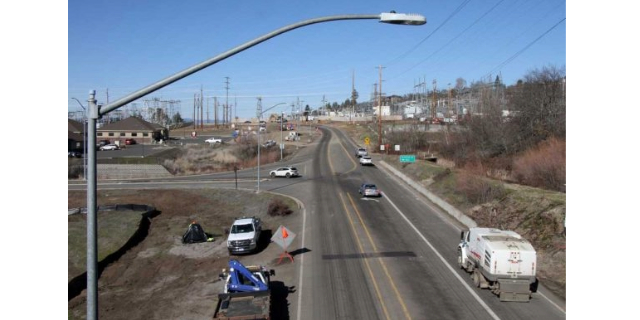BLM releases draft plan for Cascade-Siskiyou National Monument
Published 3:00 pm Monday, April 8, 2024

- Snow blankets Buck Prairie in the Cascade-Siskiyou National Monument on Jan. 1, 2022. In a newly released draft management plan for the monument, the U.S. Bureau of Land Management has decided against naming the prairie as an area of critical environmental concern that would be entitled to special protections, although the agency did designate two other areas in the monument for such protections.
A monumental planning process The U.S. Bureau of Land Management last week released its draft plan to manage the 113,507-acre Cascade-Siskiyou National Monument, located southeast of Medford. The plan and supporting documents are 618 pages. Public comments on the plan are being taken through July 5, with a final proposed plan expected in the fall. Four public meetings are set for May. Steps along the way in the planning process include the following: • Last June, the agency published a situational analysis, held “scoping meetings” and took public comment on planning issues. The situational analysis, conducted by a consultant, the Langdon Group, conducted 91 confidential interviews with key players. Topics included wildfire, logging, grazing, recreation, roads and environmental protection. Concerns also included limited BLM staff, overburdened agency staff and limited agency resources to conduct projects. • The BLM in December released a
Trending
that summarized public comments received last summer along with the percent of those comments that focused on particular issues: water, 4.6%; climate change, 4.8%; rangeland management, 6.5%; recreation, 6.7%; fish, 8.4%; fire, 9.8%; logging, 10.2%; vegetation, 10.7% and wildlife, 14.4%. Comments were received both for and against logging, grazing and off-road vehicle use. • Upcoming public meetings about the plan include an online meeting set for 6-7:30 p.m. May 8 that will include a presentation about the draft plan and environmental impact statement. Register at bit.ly/CSNMdraft. Questions may be submitted. The meeting is recommended viewing prior to joining an in-person public meeting. In-person open-house meetings are set for 5-7 p.m. May 14 at the Medford Armory, 1701 S. Pacific Highway in Medford; 5-7 p.m. May 16 at Klamath Community College, Building 4, 7390 S. Sixth St. in Klamath Falls; and 1-3 p.m. May 18 at the Pinehurst School, 15337 Highway 66. • The BLM’s project page, BLM National NEPA Register, provides the draft plan, maps, reports and a way to comment online. To view an interactive story map about monument planning topics, visit
. To comment via mail, send comments to BLM Medford District Office, ATTN: Cascade-Siskiyou National Monument Planning, 3040 Biddle Road, Medford, OR 97504. For more information or to be added to a project mailing list, contact Nikki Haskett, Cascade-Siskiyou National Monument plan project manager, at 458-246-8861, blm_csnm_rmp@blm.gov or 3040 Biddle Road, Medford, OR 97504.
Trending
The U.S. Bureau of Land Management has released a draft plan for managing the 113,507-acre Cascade-Siskiyou National Monument, including plans for fuel-reduction activities that would take place within a quarter-mile of at-risk communities.
Fuel-reduction activities could include thinning, brush-reduction and low-intensity fire. Wildfire was one of the top issues cited last summer when the agency received 189 formal comments during an initial planning phase.
The 618-page plan, including supporting documents, addresses a range of topics, including environmental protection and recreation. It calls for the creation of two new “areas of critical environmental concern” for protection, though not as many such areas as some would have liked. It also calls for a quarter-mile-wide management corridor to protect resources on each side of the Pacific Crest Trail, which crosses the monument.
In addition, the plan calls for minimal changes to livestock grazing, suggests reductions in cross-country snowmobile use and leaves open the possibility of road closures to protect and restore resources.
The agency is taking public comment on the plan through July 5 and has set four public meetings in May. A final proposed plan is due out in the fall.
In developing its plan, the BLM considered four alternatives, ranging from no change (Alternative A) to one with little active management (Alternative D). Alternative C, the preferred alternative, “promotes a moderate level of active management,” while Alternative B “promotes intensive, active management to protect monument resources.”
The BLM is required by regulation to identify a preferred alternative. “It is simply the BLM’s starting point for gaining public feedback,” according to the agency.
“We appreciate how unique and important this landscape is, not just for Oregon, but for the entire United States,” Barry Bushue, BLM Oregon/Washington state director, said last week. “We look forward to hearing from the public about how we might better manage this landscape.”
Like Bushue, Dave Willis, chairman of the Ashland-based conservation group Soda Mountain Wilderness Council, issued a written statement.
“We know BLM has been working hard on this draft document,” Willis said. “We look forward to thoroughly digesting and examining the fruits of their significant preliminary effort.”
“Managing public land to truly respect ecosystem processes and remaining wildlands is still a relatively new and novel challenge for BLM’s long-standing commodity-oriented custom and culture,” Willis said, referring to the agency’s history of involvement with logging, livestock grazing and mining. “We sincerely hope the draft plan will point toward BLM being up to their not-business-as-usual task here.”
The release of the plan follows a March 22 decision by the U.S. Supreme Court to let stand the 2017 expansion of the monument. Timber interests and others, including the Jackson County Board of Commissioners and U.S. Rep. Cliff Bentz, R-Ore., opposed the expansion and urged the court to reject it as executive overreach.
President Bill Clinton created the monument in 2000 under authority granted him by the Antiquities Act of 1906 and President Barack Obama expanded it in 2017 under the act. The original monument was about 52,000 acres, while the expansion included about 48,000 more acres, all federal land. Another 13,131 acres were acquired from willing sellers.
“With towering fir forests, sunlit oak groves, wildflower-strewn meadows, and steep canyons, the Cascade-Siskiyou National Monument is an ecological wonder, with biological diversity unmatched in the Cascade Range,” the original proclamation stated in its first sentence.
The monument’s first and only management plan was released in 2008. The new plan will guide decisions for the next 15-20 years. All alternatives must meet the direction in the proclamations to protect the monument objects, including the convergence of the Cascade, Siskiyou and Klamath ecoregions.
While Alternative C suggests two new areas of critical environmental concern, it rejects designating other areas that had been suggested as possible ACECs or as research natural areas, including Buck Prairie, Jenny Creek, Lost Lake, Moon Prairie, Old Baldy, Oregon Gulch, Scotch Creek and Tunnel Creek.
The two proposed areas are the 115-acre Cottonwood Glades area located northwest of Hyatt Lake and the 239-acre Mariposa Lily area located west of Interstate 5 near the California border, near where a wildlife overcrossing is proposed. The Cottonwood area would protect native fish, meadows, springs and fen soils by possibly restricting vehicular use and cattle. The Mariposa area would protect oak savanna and rare plants with possible management activities that include prescribed fire, removal of invasive yellow star thistle and restoration of native grasses and forbs.
Statements in the plan include the following:
• Drought and insect damage has resulted in substantial mortality within some forest ecosystems in the planning area, increasing fuel loadings and reducing resilience to fire.
• Long-term drought has led to declining stream flows and historically low reservoir levels, which affect aquatic habitats and species.
• Rivers and streams throughout the planning area have lost connections to their floodplains through beaver trapping, water diversion, road construction, timber harvest and livestock grazing.
• Habitat fragmentation and loss from uses such as timber harvest, road building, livestock grazing and fire suppression have led to degraded ecosystems.
• Habitat fragmentation from timber harvest and road building reduces habitat size, isolates plant and animal populations, limits their movement and diminishes ecological processes.
• Checkerboard ownership patterns increase the challenge of maintaining habitat connectivity.
The U.S. Bureau of Land Management last week released its draft plan to manage the 113,507-acre Cascade-Siskiyou National Monument, located southeast of Medford. The plan and supporting documents are 618 pages.
Public comments on the plan are being taken through July 5, with a final proposed plan expected in the fall. Four public meetings are set for May.
Steps along the way in the planning process include the following:
• Last June, the agency published a situational analysis, held “scoping meetings” and took public comment on planning issues. The situational analysis, conducted by a consultant, the Langdon Group, conducted 91 confidential interviews with key players. Topics included wildfire, logging, grazing, recreation, roads and environmental protection. Concerns also included limited BLM staff, overburdened agency staff and limited agency resources to conduct projects.
• The BLM in December released a scoping report that summarized public comments received last summer along with the percent of those comments that focused on particular issues: water, 4.6%; climate change, 4.8%; rangeland management, 6.5%; recreation, 6.7%; fish, 8.4%; fire, 9.8%; logging, 10.2%; vegetation, 10.7% and wildlife, 14.4%. Comments were received both for and against logging, grazing and off-road vehicle use.
• Upcoming public meetings about the plan include an online meeting set for 6-7:30 p.m. May 8 that will include a presentation about the draft plan and environmental impact statement. Register at bit.ly/CSNMdraft. Questions may be submitted. The meeting is recommended viewing prior to joining an in-person public meeting.
In-person open-house meetings are set for 5-7 p.m. May 14 at the Medford Armory, 1701 S. Pacific Highway in Medford; 5-7 p.m. May 16 at Klamath Community College, Building 4, 7390 S. Sixth St. in Klamath Falls; and 1-3 p.m. May 18 at the Pinehurst School, 15337 Highway 66.
• The BLM’s project page, BLM National NEPA Register, provides the draft plan, maps, reports and a way to comment online. To view an interactive story map about monument planning topics, visit bit.ly/CSNMstory. To comment via mail, send comments to BLM Medford District Office, ATTN: Cascade-Siskiyou National Monument Planning, 3040 Biddle Road, Medford, OR 97504.
For more information or to be added to a project mailing list, contact Nikki Haskett, Cascade-Siskiyou National Monument plan project manager, at 458-246-8861, blm_csnm_rmp@blm.gov or 3040 Biddle Road, Medford, OR 97504.









